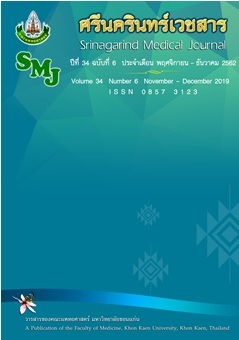Body Tanpura Therapy : An Alternative Music Instrumental Therapy for Taking Care of the End–stage Patients
Keywords:
Tanpura; Music Therapy; Alternative TherapyAbstract
Music Therapy is one of the disciplines that has been used in taking care of the end of life patients since 1970, and it has been accepted worldwide currently. The Body Tanpura is an instrument that was applied from “Tanpura”, the ancient India music instruments. It was developed in respect to the requirement of a German music therapist who used it in providing music therapy to the coma patients that have to stay in bed.
Results of research studies have revealed that the use of Body Tanpura in music therapy had positive impacts on physical health and mental health of the patients. It made the patients felt relax, calm, stimulated blood circulation, encourage positive mood, decrease depression symptom, and create the will to live. The use of this instrument also helped reduce the tension among the patient’s relatives with others.
The effectiveness of the Body Tanpura has made this instrument an interesting choice for worldwide music therapist. Moreover, the idea of modifying Tanpura to be appropriate with the patients’ body, can be an inspiration and a sparking of the idea for Thai therapists in adjusting Thai musical instruments to be appropriate in providing therapy to the patient. This adaptation may encourage better result in the music therapy, as well as, will help extend the knowledge of the music therapy science in the future.
References
2. McConnell T, Scott D, Porter S. Music therapy for end-of-life care: an updated systematic review. Palliat Med 2016; 30: 877–83.
3. คณะแพทยศาสตร์รามาธิบดี. หลักการของ Palliative care. [อินเตอร์เน็ต]. 2562. [เข้าถึงเมื่อ 25เมษายน 2562]. จาก: https://med.mahidol.ac.th/fammed/th/postgrad/doctorpalliative1th.
4. องค์การอนามัยโลก. WHO Definition of Palliative Care. [อินเตอร์เน็ต]. 2562. [เข้าถึงเมื่อ 15 เมษายน 2562]. จาก: https://www.who.int/cancer/palliative/definition/en/.
5. Munro S. Music Therapy in Palliative Hospice Care. Magnamusic Baton Inc, 1984.
6. American Music Therapy Association. About Music Therapy & AMTA. [Internet]. 2019. [cited July 3, 2019];
Available from: http://www.musictherapy.org/about/musictherapy/.
7. Dileo C. Final moments: the use of song in relationship completion. In: Advanced
practice in medical music therapy: case reports 2015. Edited by Dileo C. United States: Jeffrey Books, 2015: 273–86.
8. Bradt J, Dileo C. Music therapy for end-of-life care. Cochrane Database Syst Rev 2014; (1): CD007169.
9. Teut M, Dietrich C, Deutz B, Mittring N, Witt CM. Perceived outcomes of music therapy with body tanpura in end of life care - a qualitative pilot study. BMC Palliat Care 2014; 13: 18.
10. Oxford: CASP. Critical Appraisal Skills Programme. CASP Randomised Controlled Trial Checklist. [Internet]. 2017. [cited May 15, 2019]. Available From: http://www.casp-uk.net/casp-tools-checklists.
11. Lai H, Li Y, Lee L. Effects of music intervention with nursing presence and recorded music on psycho-physiological indices of cancer patient caregivers. J Clin Nurs 2012; 21: 745-56.
12. Thomas, Linda S. Music helps heal mind body and spirit. [Internet]. 2014. [Cited May, 5, 2019] Available From: https://journals.lww.com/nursingcriticalcare/Fulltext/2014/11000/Music_helps_heal_mind,_body,_and_spirit.6.aspx.
13. Breivik H, Collett B, Ventafridda V, Cohen R, Gallacher D. Survey of chronic pain in Europe: prevalence, impact on daily life, and treatment. Eur J Pain 2006; 10: 287-333.
14. Rudy Garred. The Ontology of Music in Music Therapy- A DialogicalView. [Internet] .2001. [Cited April, 24, 2019]. Available From: https://voices.no/index. php/voices /article/view/1604/1363.
15. Hilliard RE. The effects of music therapy on the quality and length of life of people diagnosed with terminal cancer. J Music Ther 2003; 40: 113–7.
16. Banerjee K. Indian musical instrument & making & maker, 1stedn. Parul Pakashoni, Kolkata. 2017.
17. Murrock CJ, Higgins PA. The theory of music, mood and movement to improve health outcomes. J Adv Nurs 2009; 65: 2249–57.
18. McClean S, Bunt L, Daykin N. The Healing and Spiritual Properties of Music Therapy at a Cancer Care Center. J Altern Coml Med 2012; 18: 402-7.
19. Dileo C. Music interventions for improving psychological and physical outcomes in cancer patients. USA: The Cochrane Library, 2011.
20. Warth M, Kessler J, Koenig J, Wormit AF, Hillecke TK, Bardenheuer HJ. Music therapy to promote psychological and physiological relaxation in palliative care patients: protocol of a randomized controlled trial. [Cited April 27, 2019] BMC Palliat Care 2014; 13: 60. Available From: https://doi.org/10.1186/1472-684X-13-60.
21. Gutgsell KJ, Schluchter M, Margevicius S, DeGolia PA, McLaughlin B, Harris M, Mecklenburg J, Wiencek C. Music therapy reduces pain in palliative care patients: a randomized controlled trial. J Pain Symptom Manage 2013; 45: 822-31. [Internet].2013. [Cited April 14, 2019]. Available From: https://doi.org/ 10.1016/j.jpainsymman.2012.05.008.
22. Horne - Thompson A, Grocke D. The effect of music therapy on anxiety in patients who are terminally ill. J Palliat Med 2008;11: 582-90. [Cited April, 21, 2019] Available From: https://doi.org/10.1089/jpm.2007.0193.
23. Nakayama H, Kikuta F, Takeda H. A pilot study on effectiveness of music therapy in hospice in Japan. J Music Ther 2009; 46: 160–72.
24. Oschman JL. Energy Medicine: The Scientific Basis. New York, NY: Churchill Livingstone, 121. 23.2010 Society for Design and Process Science Printed in the United States of America, 2008.
25. Groen KM. Pain assessment and management in end of life care: a survey of assessment and treatment practices of hospice music therapy and nursing professionals. J Music 2007; 44: 90–112.
26. Awikunprasert C, Vongjaturapat N, Li F, Sittiprapaporn W. Music therapy on the quality of life in cancer patients. Research on Humanities and Social Sciences 2012; 2: 13-7.
27. วิชญ์ บุญรอด, จุมพล ราชวิจิตร, ภัทรวุฒิ วัฒนศัพท์. การศึกษานำร่องการใช้หลักสูตร
เปียโน 1 to 5 เพื่อพัฒนาทักษะของผู้ป่วยมะเร็ง ระยะลุกลามโรงพยาบาลศรีนครินทร์ มหาวิทยาลัยขอนแก่น. วารสารศึกษาศาสตร์ ฉบับวิจัยบัณฑิตศึกษา มหาวิทยาลัยขอนแก่น 2558; 9: 129-38.




